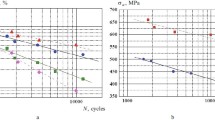Abstract
Constant amplitude fatigue crack propagation behavior and variable amplitude fatigue crack initiation and propagation behavior and R-curves were obtained at room temperature and −45°C(−50°F) for hot-rolled ASTM A572 steel. Both fatigue crack initiation and propagation resistance were better at the cold temperature. SEM fractographic analysis revealed little difference in the fatigue crack growth modes with ductile striations and secondary cracks occurring at both temperatures. Final R-curve and fatigue fracture surfaces, however, consisted of ductile dimples at room temperatures and transcrystalline cleavage at −45°C(−50°F). The hot-rolled A572 steel was found suitable for −45°C(−50°F) operating temperature despite the fact that this cold temperature is in the lower shelf CVN energy region. Fatigue design based upon room temperature conditions appears to be reasonable for this steel down to −45°C(−50°F).
Résumé
On a obtenu à la température ambiante et à −45°C le comportement à la propagation de fissure de fatigue à amplitude constante et le comportement à l'amorçage et à la propagation de fissure de fatigue sous amplitude variable anisi que les courbes R relatifs à l'acier ASTM A.572 laminé à chaud. On a trouvé que la résistance à l'amorçage et à la propagation d'une fissure de fatigue était meilleure à basse température. L'analyse fractographique à la sonde a révélé de légères différences dans les modes de croissance d'une fissure de fatigue avec la présence aux deux températures de striures ductiles et de fissurations secondaires. Toutefois, les surfaces de rupture correspondant à la courbe R et à la fatigue comportaient des cupules ductiles à température ambiante et des clivages transcristallins à −45°C. On a trouvé que l'acier laminé à chaud A.572 était applicable aux utilisations à la température de −45°C en dépit du fait que cette température se trouve dans la partie inférieure de la courbe de transition Charpy V. Il apparaît également raisonnable d'étendre une conception à la fatigue basée sur des conditions à température ambiante jusqu'à des températures de l'ordre de −45°C pour cet acier.
Similar content being viewed by others
References
P.G. Forrest, Fatigue of Metals, Pergamon Press (1962).
N.E. Frost, K.J. Marsh and L.P. Pook, Metal Fatigue, Oxford University Press (1974).
H.O. Fuchs and R.I. Stephens, Metal Fatigue in Engineering, Wiley Interscience (1980).
R.I. Stephens, J.H. Chung and G. Glinka, SAE Transactions, paper No. 790517 (1979) 1892.
W.W. Gerberich and N.R. Moody, in Fatigue Mechanisms, Ed. J.T. Fong, ASTM STP 675, 292
R.L. Tobler and R.P. Reed, “Fatigue Crack Growth Resistance of Structural Alloys at Cryogenic Temperatures”, Presented at the Cryogenic Engineering Conference/International Cryogenic Materials Conference, University of Boulder, Colorado, August, 1977.
R.M. Wetzel, Ed., Fatigue Under Complex Loading: Analysis and Experiments, SAE Publication AE-6 (1977).
W.K. Wilson, J. of Pressure Vessel and Technology, ASME, 96 No. 4 (1974) 293.
S. Neal, L.W. Zachary and C.P. Burger, SAE paper 780104 (1978).
T. Kawasaki, T. Yokobori, Y. Sawaki, S. Nakanishi and H. Izumi, in Fracture 1977, ICF-4, Vol. 3, Waterloo, Canada (1977) 857.
R.I. Stephens, G.O. Njus and A. Fatemi, “Fatigue Crack Growth Under Constant and Variable Amplitude Loading of Cast Steel at Room and Low Temperature, Proceedings International Conference on Fracture, ICF-5, Cannes, France, April 1981.
Author information
Authors and Affiliations
Rights and permissions
About this article
Cite this article
Stephens, R.I., Lee, S.G. & Lee, H.W. Constant and variable amplitude fatigue behavior and fracture of A572 steel at 25°C(77°F) and −45°C(−50°F). Int J Fract 19, 83–98 (1982). https://doi.org/10.1007/BF00016566
Received:
Issue Date:
DOI: https://doi.org/10.1007/BF00016566




